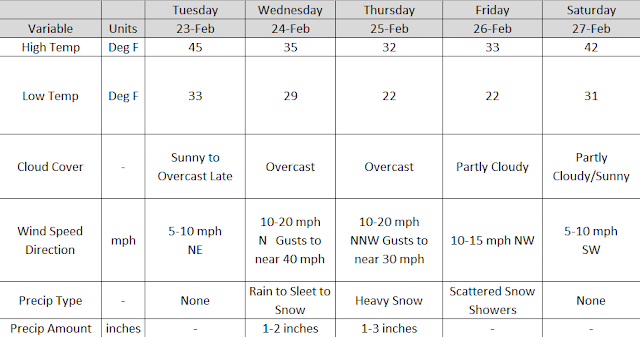Please share this post with friends, family, and coworkers. Information provided in this article is very important.
Below is a picture of the sunrise in Carroll County on the way into Kokomo this morning. Although we don't have a wide open ocean or mountains, there is nothing quite like an Indiana sunrise.
Beautiful Indiana sunrises can sometimes help you forget how destructive mother nature can be. Everyone has been affected by a particular weather event, whether it was in early childhood or late in life. I remember the funnel cloud passing over my parents house from the 1998 tornado that struck Taylor High School. I also fondly remember watching one of two November 2013 tornadoes form just south of Russiaville, cross State Road 26 and strike houses just south of 500W, hit the neighborhood north and east of the American Legion Golf Course, and damage homes in the Cedar Crest neighborhood. Luckily, neither of these events caused deaths in Kokomo. Unfortunately, not all communities are lucky enough to go death free for severe weather events. One of the deadliest tornadoes in United States history, The Tri-State Tornado, occurred on March 18, 1925. This tornado traveled over 300 miles, claimed 695 lives, and injured over 2,000 individuals. See below the tornado track image below obtained from a NOAA review of the 1925 Tri-State Tornado.
http://www.weather.gov/pah/1925Tornado_nvt_sub
The April 11th 1965 Palm Sunday Tornado Outbreak struck a little closer to home. A F4 tornado nearly destroyed Russiaville, Alto, Kokomo, and Greentown. The tornado was on the ground for 48 miles from Russiaville to Marion, killing 25 people through its path. I found a video of the damage on YouTube that you may find interesting. The link is here: https://www.youtube.com/watch?v=LQ68Ns_kd4U.
Tornado Path through Howard County Palm Sunday 1965
http://www.weather.gov/ind/rusaltkok Courtesy: Kokomo Morning Times
Damage in Russiaville from 1965 Palm Sunday Tornado
http://www.weather.gov/ind/rusaltkok Courtesy: Kokomo Morning Times
Damage in Alto from 1965 Palm Sunday Tornado
http://www.weather.gov/ind/rusaltkok Courtesy: Kokomo Morning Times
Kokomo 1965 Palm Sunday Tornado
http://www.weather.gov/ind/rusaltkok Courtesy: Kokomo Morning Times
Damage in Kokomo from 1965 Palm Sunday Tornado
You see, we aren't invincible. Severe weather HAS happened here, and COULD happen again in some form or another. It is our job to prepare for the worst and hope for the best. Events like these is why you should be Severe Weather Prepared.
Tips for Being Severe Weather Prepared
Severe weather happens everywhere in the United States and can strike at any time of the year. Yesterday, we discussed the differences between severe weather watches and warnings. The link for this post is: www.boileragandweather.blogspot.com. Scroll down and you can find the post titled "Understanding the Difference Between Severe Weather Watches and Warnings". Today's post is dedicated to helping you become Storm Ready to reduce your risk of being harmed or worse being killed.
Before severe weather strikes, you should have a plan that is specific to you and your family.
- Have a supply kit with emergency supplies such as water, food, battery-powered radio, first aid kit, a whistle, flash light, disinfectant wipes, blanket, can opener, and sturdy shoes. You can store all of these supplies inside a small suitcase to help with survival needs during severe weather situations. You find a full list of supplies here: https://www.wunderground.com/prepare/disaster_supply_kit.asp.
- Establish a meeting place during times of severe weather. This should be a location that is the most interior location on the lowest floor within your home, an underground shelter, or basement. My parents home does not have a basement, but we found shelter in a closet underneath their stair case. If you are fortunate enough to have a close neighbor with a basement, make it a priority to have a backup plan to shelter with them.

- Have a family communications plan established. Try to stay in contact with your immediate family to ensure they are safe. If all possible, use land phone lines to alleviate the amount of traffic on cellular networks. I remember during the November 2013 tornado, it was very difficult to make phone calls over cellular networks. Being a weather nerd, I call and contact family if I see storms that look to be severe in advance.
- Have a NOAA Weather Radio that alerts you for severe weather watches and warnings that are within your county. I would also recommend programming your NOAA Weather Radio to a two county radius around Howard County. This will help improve your warning time and keep you informed of incoming storms. REMEMBER: Not all locations within Howard County have alert sirens. Weather Radios can save lives!


- Pay attention to local storm team coverage on radio networks or news stations. Also, don't get upset when news stations interrupt your favorite television program... If they are interrupting your programs, there is definitely something serious going on. They are doing their jobs to make sure the public is informed of severe weather. The more warning time the public has, the greater chance for reducing potential injuries and deaths. Local radio stations, such as WWKI and Z92.5 have storm team coverage that you can tune into during severe weather events.

- If you are not near a shelter location, DO NOT stop and shelter under road overpasses. Debris from a tornado can get lodged up underneath overpasses. It is recommended to find a low-lying ditch to seek shelter. DO NOT try to outrun a tornado. Leave the vehicle and shelter immediately.
- DO NOT storm chase, unless you are trained. Even then, I do not recommend storm chasing.
As you can see, there are many things you can do to make yourself prepared for severe weather.
If Tornado Warnings are issued for your county, SHELTER IMMEDIATELY!
A few useful links pertaining to severe weather preparedness are listed below.
http://www.nws.noaa.gov/com/weatherreadynation/force.html
http://www.in.gov/dhs/3163.htm
If you have questions, please post in comments below or shoot me an email at pearsona@purdue.edu.




















